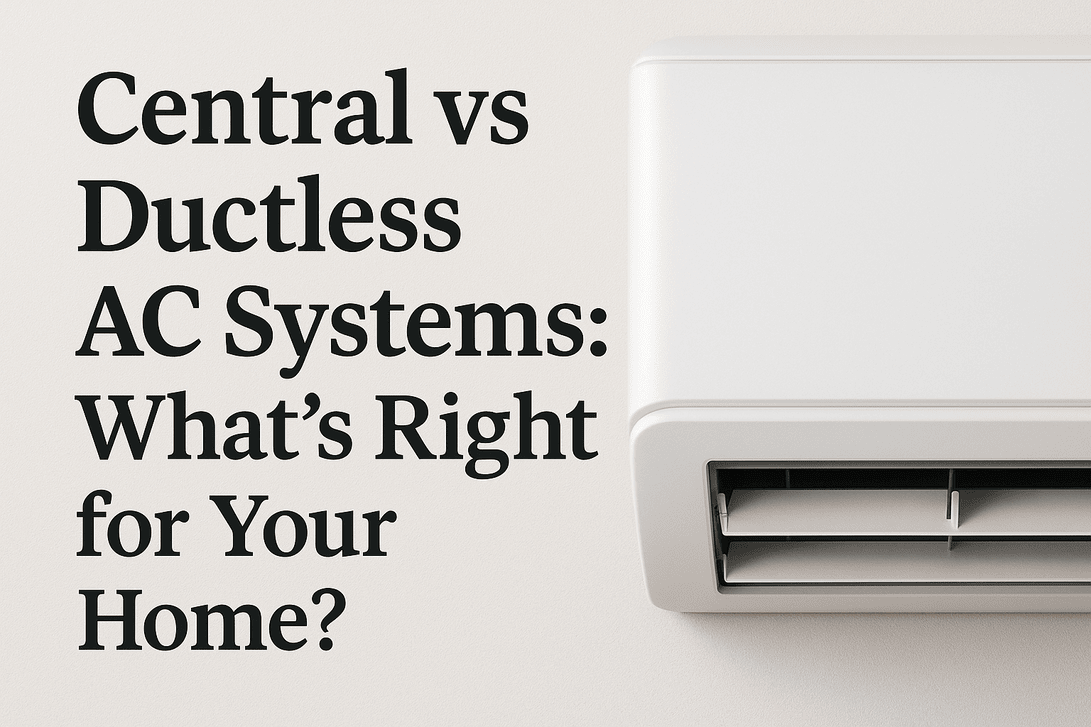Choosing the right air conditioning system is a significant decision for any homeowner. Whether you’re renovating, building new, or simply upgrading, understanding the difference between central air conditioning systems and ductless mini-split systems is crucial. Each offers distinct advantages and drawbacks depending on your budget, home layout, climate, and personal preferences.
This guide compares central vs ductless AC systems in terms of performance, installation, energy efficiency, cost, and ideal user scenarios. By the end, you’ll be equipped to make the best cooling choice for your home.
What Is a Central Air Conditioning System?
Overview
A central air conditioning system uses a large compressor unit, typically located outside the house, and a network of ductwork to distribute cool air throughout your home via vents.
Key Components
- Outdoor unit (compressor & condenser)
- Indoor unit (air handler or furnace)
- Thermostat
- Duct system
What Is a Ductless AC System?
Overview
Also known as mini-splits, ductless systems have one or more indoor air handlers that are directly connected to an outdoor condenser. These systems do not require ductwork.
Key Components
- Outdoor compressor unit
- Wall-mounted indoor units (1–8 per home)
- Remote or smart thermostat (per zone)
Installation: Ducted vs Ductless
Central AC Installation
- Complex and Invasive: Requires significant remodeling if ductwork is not already in place.
- Longer Installation Time: Typically 3–5 days.
- Best for: New builds or homes with existing ductwork.
Ductless AC Installation
- Quick and Minimal Invasion: Wall-mounted units require only a 3-inch hole for refrigerant lines.
- Faster Installation: Typically completed in 1–2 days.
- Best for: Homes without ducts, additions, older properties, or individual room upgrades.
Cost Comparison
Initial Cost
| System Type | Average Equipment + Installation Cost |
| Central AC | $5,000 – $12,000 |
| Ductless AC | $3,000 – $10,000 (per zone) |
Note: Ductless systems often require multiple units for whole-house coverage, which can raise costs.
Maintenance Costs
- Central AC: More expensive long-term due to duct cleaning, filter changes, and potential leaks.
- Ductless AC: Lower maintenance, but filters must be cleaned monthly.
Lifespan
Both systems last 12–20 years with proper maintenance, but ductless systems tend to perform better in highly humid areas.
Energy Efficiency
Duct Losses
- Central systems lose up to 30% of energy through ductwork (especially in unconditioned spaces like attics).
- Ductless systems avoid this entirely, offering higher SEER ratings (Seasonal Energy Efficiency Ratio).
Zoned Cooling
- Ductless AC: Each unit operates independently, allowing zoned cooling and reduced energy use in unused spaces.
- Central AC: Requires a zoned HVAC system or smart dampers to achieve similar control, which adds cost.
Aesthetic and Design Considerations
Central AC
- Invisible Inside: No visible components inside the room except for vents.
- Space Requirements: Needs significant attic, basement, or closet space for ductwork.
Ductless AC
- Visible Units: Wall-mounted or ceiling cassette units are always in sight.
- Flexibility: Easier to integrate in homes with limited space or specific room needs.
Noise Levels
- Central Systems: Generally quieter inside the home, but compressors outside can be noisy.
- Ductless Systems: Quieter operation overall, especially with inverter technology, though some may notice the hum of indoor units.
Ideal Customer Segments
Central AC Is Ideal For:
- Large homes with existing ductwork
- Homeowners preferring hidden systems
- Families needing whole-home uniform cooling
- Buyers planning long-term ownership
Ductless AC Is Ideal For:
- Homes without ductwork (e.g., older homes, cabins)
- Additions, garages, and sunrooms
- Homeowners prioritizing zoned control and energy efficiency
- Renters or those wanting low-impact installations
Environmental Impact
- Ductless mini-splits use less energy, making them more environmentally friendly.
- Modern systems from both categories use R-410A or R-32 refrigerants, which have lower ozone depletion potential.
- Smart thermostats and inverter compressors further boost efficiency.
Smart Features & Automation
Central Systems:
- Often integrate with whole-home automation systems.
- Compatible with smart thermostats like Nest or Ecobee.
Ductless Systems:
- Many models include Wi-Fi connectivity out of the box.
- App-controlled per zone; ideal for tech-savvy users.
Common Myths Debunked
“Ductless Can’t Cool Large Homes”
Wrong. Multi-zone ductless systems can cool homes up to 3,000+ sq. ft.
“Central AC Is Always More Powerful”
Not true. High-efficiency ductless systems often outperform outdated central units.
“Ductless Units Are Ugly”
Subjective. Modern slimline indoor units are sleek and low-profile.
Final Verdict: Which Is Right for Your Home?
| Category | Winner |
| Initial Cost | Ductless (single zone) |
| Whole-Home Cooling | Central |
| Energy Efficiency | Ductless |
| Installation Speed | Ductless |
| Aesthetics | Central |
| Zoning Flexibility | Ductless |
| Smart Features | Tie (depends on brand) |
Conclusion
The decision between central vs ductless AC systems comes down to home layout, budget, aesthetic preferences, and cooling needs. If you’re upgrading an older home or need flexible room-by-room control, ductless AC is a powerful, efficient solution. For large homes with ductwork or whole-home comfort in mind, a central system may offer better value.
Before making your choice, consult with an HVAC professional to evaluate your space, climate zone, and long-term energy goals. Smart cooling is more than just comfort—it’s an investment in efficiency, health, and home value.


